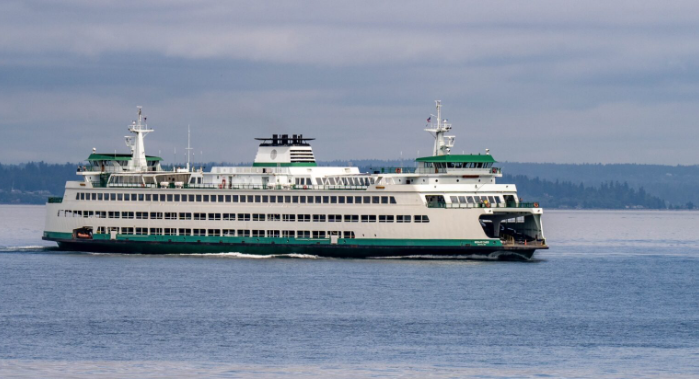||| FROM ALEX MCLEOD for SALISH CURRENT |||
There have been a number of overview stories recently about Washington State Ferries, including Tom Banse’s good one May 31 in Salish Current. They seem to have been occasioned by WSF finally issuing bid documents for the first new hybrid-electric ferries, the first of which may join WSF’s aging and depleted fleet in 2028.
For those of us in San Juan County, dependent on ferries to connect us to one another and to the mainland, this announcement did nothing but underscore that the reality that our ferry service — bad as it’s ever been — is only going to get worse.
If past is prologue, the cost of these new ferries will far exceed the $250-million-per-boat budget (the previous bid, two years ago, was for nearly $400 million), there will be long delays trying to negotiate down the price and/or find new money and the legislature will dither.
Meanwhile, and well beyond whenever the first new ferries join the fleet, we will be left with ferries well beyond their expected lifespans, estimated by WSF to be 30 years. Our interisland link, the Tillikum, was built in the last years of Dwight Eisenhower’s presidency, 65 years ago. Two others already are 57 and 43 years old, and already they frequently miss sailings with mechanical issues.
To try to hold off mechanical problems, the three ferries that sail from Anacortes — when they aren’t broken down — now operate at about three-quarter speed, putting them behind schedule. Last summer fewer than half of all sailings arrived or departed on time. (Boosting the numbers, WSF doesn’t even count ferries that miss sailings entirely because of mechanical problems or insufficient crew.)
Now WSF is running a “task force” to redo the sailing schedules on our routes to try to achieve departure and arrivals closer to “on time.” To do that, WSF is clear that the number of sailings will have to be cut. How much is unclear still, but an informed guess is a cut of up to 15%. As that becomes clear, along with the WSF bureaucrats’ lack of patience with any pushback, tension on the taskforce is growing, with WSF staff complaining about expressions of “victimhood” from the citizen members.
Victimhood for trying to get straight answers? Victimhood for trying to maintain capacity when reliability and staffing already are problems? Trading aspirational on-time service for actual sailings?
**If you are reading theOrcasonian for free, thank your fellow islanders. If you would like to support theOrcasonian CLICK HERE to set your modestly-priced, voluntary subscription. Otherwise, no worries; we’re happy to share with you.**








The WSF System is not wholly to blame, and like many institutional failures (see below), people on both sides of the service transaction get personal at their opposite numbers. Like many small areas in a state that initially imposed a legal requirement that all WSFS ferries be built in this state (only to find no in-state boat builder able to meet specs), the law had to be changed.
Next is cost, an arguable niche in the state highway system that competes for funds against the rest of the state. Like some counties East of the mountains, our population is not large, but unlike them, our main economic function is not primarily production of consumable and exportable goods, but simply a place emphasizing natural beauty for those who can afford to live there, and the ephemeral sharing of that experience we call tourism. This can be and I’m sure has been a hard sell in the Legislature at budget time.
Those who serve us in the WSFS aren’t having a lot of fun and so far as I can tell considering budget problems, rarely have. They are our lifeline- it isn’t just boats, it’s people as we know so well from vessels not sailing for lack of crew. Our county needs to continue to be strongly pro-active in support, not criticism of WSFS at this point, and of the legislation and funding needed to jump into the future. And we as individuals can be more than barely civil to those we directly interact with those in WSFS we interact with. We don’t need crew-less boats.
Meanwhile, interesting times are coming. This is a ride we’re all taking together.
I’m appreciative of the service WSF crews provide; however, I suspect the WSDOT/WSF system staff are sometimes disingenuous in blaming slowing speeds on the desire to not tax the aged ferries when I was told a couple of years ago that the fuel increases of the past few years necessitated slowing the boats (to keep the fuel consumption within budget).
Thank you, ALEX MCLEOD, for ringing this bell. The past is indeed prologue: in an echo of the MVET story, initiatives are on the fall ballot to repeal the state carbon market and capital gains tax. If these initiatives pass, the hole blown in the state budget will be large enough to prevent significant improvements in many state services, including WSF, for the foreseeable future. The initiative backers are currently filing suit to prevent the SoS from including fiscal impact statements with the ballot language – evidently they prefer an ignorant electorate (the 6/6 Washington State Standard has a report, as does The Seattle Times).
Alex McLeod’s depressing article that ferry service will get worse for the San Juan routes might or might not happen, but it’s got too many “facts” and opinion issues that it’s hardly worth the electrons and ink to publish.
Quick summary:
Ferries are not 30 year vessels. They are intended for 60 years of service, same as British Columbia ferries. They all go routine shipyard maintenance, and at around 30 years, they undergo major equipment and cabin refurbishment.
Current fJC ferries operated between 16 and 17 knots. That is slightly below their designed top speed, and is a fuels and diesel pollution decision. Fuel use is almost logarithmic with higher speeds.
As of 2020, with 8 new ferries built between 2010 and 2018, the WSF fleet was statistically the newest average age since the fleet as acquired in 1953. Caveat: This is using the 30 year major overhaul as start over dates since it’s reasonably close to a completely reconditioned vessel.
MVET is not going to be restored. That’s two decades old history now, decision by voters and the State Legislature.
The governor has FAR more on his plate than ferries. The WSF system is part of the Department of Transportation (DOT) where it belongs. Fair comment that ferry service hasn’t been getting sufficient attention from the head of DOT as it deserves.
San Juan County population is just under 19,000. Washington State’s 2024 population 2024 is 7.95 million. So all of SJC is about .002% of Washington State population.The WSF plan classified SJC routes as either commuter or recreation routes in 2009 … SJC ferry service was (and still is) considered ferry recreation routes. The SJC ferry advisory committee and County Council did not understand what that would mean for the future of SJC ferry service when that plan was published and commented on. Good news is that WSF management has now recognized that having no bridges means more than a recreation travel mindset as to providing service to San Juan County.
The agonizingly long San Juan ferry schedule rewrite may or may not result in fewer ferry legs. Good news is that at least the dwell times will be more realistic, and hopefully the on time performance might get up into the 90%+ range.
Staffing and unions agreements are too complicated for this discussion.
As beleaguered as San Jun County residents are by the untenable ferry situation, we’re fortunate to have three prospective county council candidates who have insight and/or direct experience with the ferries, all of whom have expressed their views in recent interviews on Friday Harbor’s CNL 2 https://cnl2.com/category/county-elections. Candidate Kari McVeigh points out that riders in the Vashon triangle route have been successful in getting Olympia’s attention and obtaining supplemental funding for alternative services, and that the first thing that’s needed is for the San Juan County Council to go to the legislature with a clear plan and ask. Candidate Justin Paulsen has long served on the County’s Ferry Advisory Committee and is thoroughly familiar with the details and politics of the situation; and Candidate Rick Hughes spent considerable time in Olympia during his past council term, lobbying for improved ferry service. Each of these candidates would complement and strengthen the efforts of continuing Councilmember Jane Fuller to lobby for improved service.
That said, current discussions have focused on how to improve or supplement ferry service, with not much hope in sight for either new boats or additional crew in the near future. What hasn’t been discussed, as far as I know, is how to make the best use of what we have, with the exception of reducing scheduled service to accommodate for missing boats and crews; i.e., get used to it. So this is now no longer a question of improvement but of triage. If there is no visible solution on the supply side, why not then talk about reduction in demand? And if we are essentially in an emergency triage situation, why not prioritize demand for those who need it most–local residents and suppliers? I have heard the argument that, because ferries are supported by state-wide transportation tax, they are essentially a state highway and must legally be open to all travelers. I don’t buy it. For Islanders, the ferry is our only “highway” for goods, services, business and essential personal travel. During emergencies, public roads can certainly be limited to local resident access. Now is the time to make the distinction between our ferries as a commuter route and a recreational route. It’s time to give County residents priority boarding as commuters over recreational visitors.
Reliability is the PRIMARY requirement for islanders, island businesses and visitors. Obviously we would all like a ferry to run at the times we personally find convenient but you cannot please all the people all the time… The 8:45 from Orcas to Anacortes and the return at 3:40 are by FAR the most desirable runs for Orcas islanders. So put a BIG boat on those runs and make sure the boat works and is staffed! Why is that so difficult?
I would far rather have fewer runs as long as there were a couple of boats at useful times of day that actually ran reliably. But they MUST run on time and every time. The existing unreliability is intolerable.
Long term, the only way to insure we have sane inter-island service is to operate our own fleet of boats. Kitsap county transit is already far ahead of us on this:
https://www.kitsaptransit.com/static/509/electric-fast-foil-ferry
Ultimately I believe we should push for SJC owned boats to provide fast passenger/light cargo service to the mainland as well. The grocery trucks can take the WSF mega ferries. It’s beyond absurd to use a gigantic, expensive to buy, maintain and operate vessel to move human beings around. We simply cannot continue to rely solely on the state to provide access to our homes in the archipelago.
The state actively prevents any commercial ferry from operating on state routes and that policy simply has to end. The state monopoly is failing to serve us and is preventing any viable alternatives from developing.
@Ken Wood — on the topic of fast passenger ferries, am I the only one who believes that it’s unconscionable that the WUTC has allowed the Victoria Clipper to “temporarily” suspend service for the each of the last 3 years running (not counting 2020-2022 because of the pandemic)? Part of the UTC charter is to ensure critical transportation infrastructure needs are met, and it certainly seems like the WSF is close to getting to a critical point.
Admittedly, from a local residents’ perspective, this topic is for transportation to/from Seattle, not the day trips to Anacortes/Bellingham, but nonetheless it could offload much of the traffic of those visiting the San Juans from Seattle, freeing up ferry space for others.
At least in granting this year’s petition from Clipper, the WUTC did at least say that some other operator would be allowed to take up the route. Any takers?
https://apiproxy.utc.wa.gov/cases/GetDocument%3FdocID%3D21%26year%3D2023%26docketNumber%3D230253
REDUCTION IN DEMAND:
Like most of us I get a “Wave and Go” – 5 trips in a 90 day period. How many times have I come to the end of the period with one day remaining, so I book an unnecessary trip to get full value. Extend the period to 120 days. That would cut 2-3 trips per year for me, times how many others?
Just a thought.
Good idea Phil Peterson! I usually wind up giving away the last ride on my multi-pass card or worse, forgetting it’s expiring and wasting it. Extending the period to 120 days would definitely help me; not sure if it would actually make any difference in demand.
@Ken Wood: “Long term, the only way to insure we have sane inter-island service is to operate our own fleet of boats. Kitsap county transit is already far ahead of us on this … ”
New ideas are always welcome for new consideration. But having watched the fully evolution of the Kitsap Transit ferries, they have had their unreliability issues, crew issues, repair issues, weather issues, and most importantly, they are designed for relatively known demand commuter routes. And of course there is the addition of sales taxes in Kitsap County, and support from the county and cities the ferries serve. And of course grants and more grants.
Almost anything can be done with enough money. SJC also doesn’t have a large work force to employ as ferry workers, and the Coast Guard isn’t going to allow a public transit ferry to leave port without sufficient crew in the event there is an accident or in worse case, a loss of buoyancy.
And of course, just like WSF, there has to be back-up vessels and shipyard repairs and refurbishments.
So feel free to lay out your big picture plan of where the ferries might run, what days, and what a early ballpark estimation of cost might be.
And I encourage any citizen to ask the same questions of County Council candidates whether their idea of a SJC ferry system is worthy of the years of planning and costs it would take to establish a viable alternative transportation alternative.